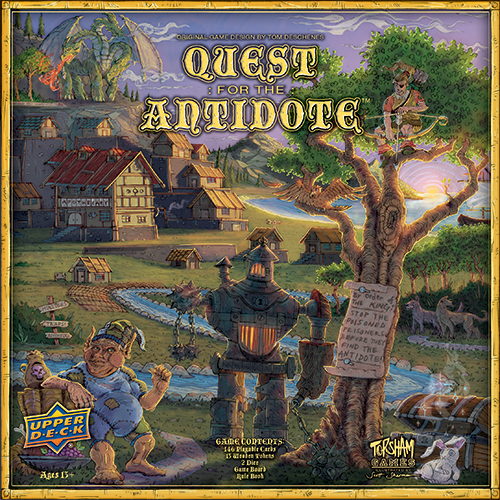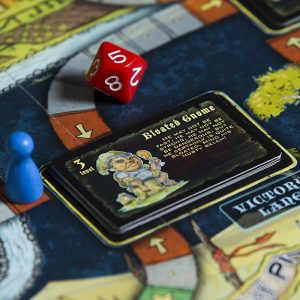
I’ve been poisoned.
Bugger.
Luckily, help is at hand. A nearby apothecary can make an antidote just as long as I can find all of the ingredients and get them back to him before I run out of breath and keel over in a pile of deadness. Pretty sure that’s a word. So I’ll go on a quest, a quest to save my life before others can grab the ingredients and save themselves. A quest of survival. A quest of battling beasties, grabbing cool loot and beating up other poisoned people. We’re off on a Quest for the Antidote.
First thing’s first, if you don’t like those slightly older style board games that rely on dice rolls for movement, you might as well go somewhere else for a bit, because the idea of Quest for the Antidote is to roll your movement dice, make your way to various spots around the board and get back again in a set number of moves. There’s a little more to it than that, but in terms of movement that’s literally all there is to it. If that sounds ok, read on. If not, maybe take a look at some of our other reviews instead.
You’ll start the game with 4 ingredients that you need to collect, all situated on the edge of the board somewhere. You start in the middle (obviously, wouldn’t want to make this too easy) and on each turn roll the 6 sided movement dice and trundle off in whichever direction takes your fancy. You can just move that many spaces, or stop and head back the way you came if you’re about to hit a monster that you’d rather avoid; as long as you move the right number of spaces it doesn’t matter which direction you go. Chances are though, given that you only have 50 breaths in order to complete the quest and moving uses up a one of them each time, you’ll want to get a move on. Straight away this brings up an age old issue with roll-to-move games, and that’s if you end up on an unlucky streak and roll lots of 1s and 2s for a while. It doesn’t matter how far you move, it still uses up a breath, and if you fight a monster that’s quite powerful (you don’t see them until you get there) then you could end up in more trouble because of another dice roll.
For combat, there’s a 10 sided dice. When you reveal a monster it’ll have a rating out of 9, and you need to beat it to move on. Each failure takes your breath away (as Berlin almost once sang), so a powerful enemy could very easily knock you some way closer to death. On the flip side though, the beefier enemies will potentially drop loot for you to grab, which is a nice reward for choosing to do battle in the first place, just as long as you do actually kill it and don’t lose your last 42 breaths being unable to roll a high enough number.

So aside from the obvious problem of falling behind other players, some unlucky rolls could eventually take you out of the game entirely, leaving you watching from the sidelines. Not ideal. But it’s unfair on the game to focus on these slightly negative points, because under all that is a pretty fun game. You can challenge other players if you land on their space, letting you steal one of their ingredients if you win the duel. There’s a hefty breath penalty if you lose so it’s risky, but it’s good fun to have a pop at another player as long as you’re with people who can see the lighter side of being attacked.
But while we’re attacking other players, let’s deal with the meddling cards which let you have a pretty big impact on another player that you choose. You can play these cards which will potentially turn someone’s game upside down, which can be pretty brutal in certain situations, but are certainly good for a laugh assuming, again, the other players are happy to go from a winning position to a losing one in the space of a couple of turns. You can also discard them to get some breath back, so if you’ve had a pretty violent fight with a monster you can quite easily recover a few spaces, but with only 4 cards at your disposal it’s not a strategy to employ repeatedly.
But one thing that’s definitely worth pointing out is the rule tweaks listed in the rulebook. There are ways to make the game less confrontational, or more confrontational if that’s your thing, or you can just make them up yourself. Get rid of the meddling cards, reduce the penalty for losing a duel, allow a double dice roll when fighting monsters, do away with the breath system entirely; the game’s mechanics are so straightforward making up your own tweaks to suit the players you’ve got is a breeze. Simply just taking out the meddling cards was enough for me to play the game easily with my 5 year old without any difficulty – there are no secret cards other than those meddling ones, so you can happily read the monster cards for younger kids, and as long as you go easy in terms of strategy and duelling you can have a lot of fun with a younger audience.
So this is clearly an older style of game in the way it works. Roll dice, move, collect stuff, win. But it’s a really cool game for those times you want something lighter, something to play with the family or those friends who aren’t board game obsessives. There’s fun to be had here with the right people, and as long as you’re expecting nothing other than a dice-based game of collecting things and dice-based simple combat then it’s very decent. There are better gateway games for sure, but this is worth looking into when you’re next looking to bolster your family games collection.

Leave a Reply